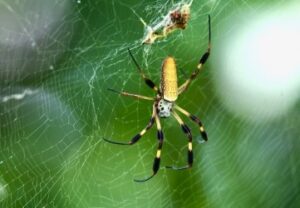
By Mary Reid Barrow with Denise Maples and Spinella the spider
Photos by Denise Maples
Meet Denise Maples’ new friend whom she has named Spinella. Spinella is a golden-silk orb weaver or banana spider, her nickname south of here.
Spinella spun her big sprawling web on the fence between Denise’s and her neighbor’s yard in Kempsville.
“You can’t miss her,” Denise said. “She’s the size of my palm with those legs.”
At first glance, Denise thought Spinella was an old friend, and local favorite, the garden spider or sewing machine spider. But then she noticed her “beautiful colors.”
Though Spinella spins a big spiral web, there is no sewing machine stitch in the center. But she seems to hang right in the middle of the web, like a garden spider does, Denise said.
“As soon as an insect hits the web, BAM! She’s on it,” Denise added, “I sure would hate for her to jump on me! She’s fast!”
Though fast, if she were to bite, Spinella is a non-venomous spider and nothing to fear.
Denise also sent a photo of Spinella’s black and yellow underbelly which is just as beautiful as the upper side, she said.

The common name, banana spider, comes from its long shape, the color of a banana. “Banana spider” also is the nickname of another species of spider found around banana plants in South America.
Insect guides list the golden-silk orb weaver (Trichonephila clavipes) as Southeastern United States natives. Maurice Cullen, one of my go-to experts, says he has never seen one here, but he has in Florida. Its range extends to North Carolina and with our warmer summers, he can imagine the spiders reaching Virginia Beach, he said.
Now, let’s hope a little male Spinello is lurking out there waiting for an opportune time to jump into Spinella’s web and bring forth a new spider dynasty in Denise’s yard!
More Backyard finds: Do you have a banana spider in your yard? Last week, Joe DiGeronimo spied a young male black scoter off the Chesapeake Bay beach, Jenny Johnson had a visit from an unusual leaf-footed bug nymph, and a squirrel appears to be nesting in Marianne Seibel’s watering can that hangs from a tree!
Also, teacher Susan Fleenor found 7 monarch caterpillars that she hopes to distribute to students to raise, and Mary Broome has seen Mississippi kites that appear to be nesting in Alanton. More on some of these later!